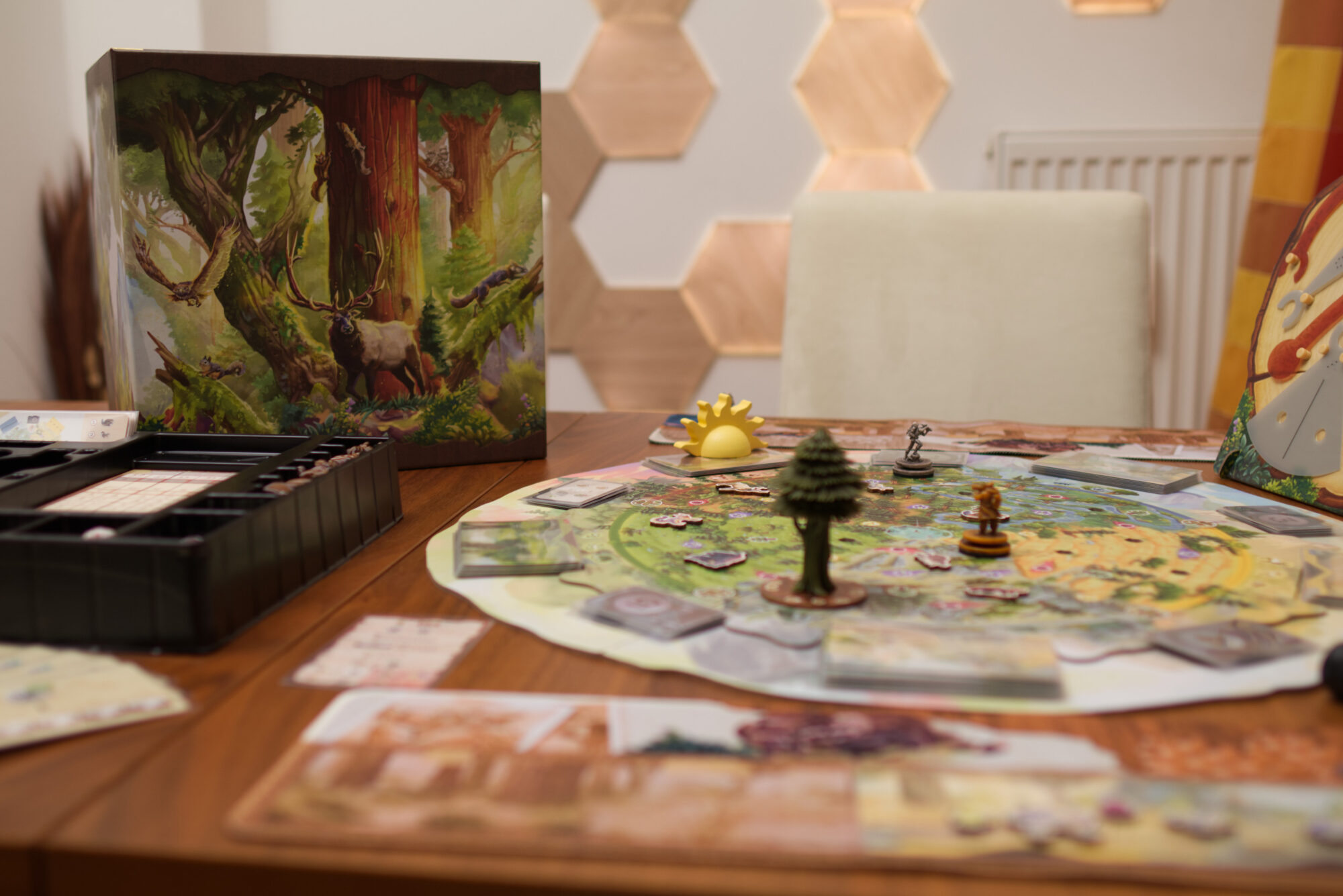Do you know that feeling when you see a crowd funding project and immediately fall in love with its visual presentation but at the same time get super skeptical regarding its game play? It just looks too good? There are positive and negative surprises when venturing into that territory. For example, I remember first seeing ICE and Mosaic and being indecisive for the whole span of the campaign: should I back them or not, back them or not? I went back and forth multiple times and in the end picked up a copy on the secondary market to satisfy my curiosity. In those cases, my initial feelings had been right and I found those games were not for me. They looked great but the playing experiences felt lacking. A positive example was Rolling Heights, which looked amazing but its gimmicky premise of rolling meeples kept me from backing it. I later got a copy and still enjoy playing it to this day. Is it perfect? No. But still, a lot of fun.
Redwood was another one of those games: it looked amazing but I just wasn’t sure how much game would be behind all that glorious art. The theme of wildlife photography also was very enticing to me and I liked patter-move-games in the past, like 2005’s Techno Witches. My main problem there wasn’t with the game itself but that no one wanted to play it with me. After all, it is a very basic game mechanism.
I recently had the chance to acquire the all-in big box of Redwood for a price I couldn’t say no to and so it became another “oh heck, if it’s not for me, I’ll definitely be able to flip it for THAT price” … the last time I ushered those words I ended up having to clear a whole section of my shelf because it unfortunately turned out I actually liked Foundations of Rome! Let’s see where Redwood falls: keeper or soon to be re-sold?

Unboxing
First of all: oh my god, is this box big! I had only seen the renders on the Kickstarter page and thus was completely surprised when I saw the size of box Redwood came in. Imagine three Ticket to Ride boxes stacked on top of each other and you’re pretty much there. To be fair, it said “big box”, but I was expecting maybe a La Granja Deluxe or Suburbia Collector’s Edition, not this!

There is a lot going on here. The gameplay content of Redwood can be split into four broad categories: base game, expansion content, Kickstarter stretch goals, and big box exclusives. Then there are some additional add-ons like neoprene player mats and wooden replacements for cardboard tiles. I’ll discuss all of these in a later section, but for now, let’s focus on the base game.

Setup
Setup overall isn’t bad: unfold the main board, separate and shuffle the panorama cards which basically show the background players will be photographing. Those are placed in indentions corresponding to their sectors, of which there are five in total. In a similar fashion, there are objective cards marked 1 to 5 and one of each is drawn, placed in indentions, and only the first one is revealed. These show conditions to achieve bonus points but also act as the turn counter of the game. Redwood is a rather short game and is played over just five rounds where each player executes a move and then frames a picture to be taken.

There is also a set of so called sunrise cards which basically provide a randomise starting position for the 7 different animals that will be on the board as well as in which sector the sun starts (more on that later). Otherwise each player picks a colour and gets two very lovely minis for it (they even come dry-washed in the KS editions), a player board, and that’s pretty much it.
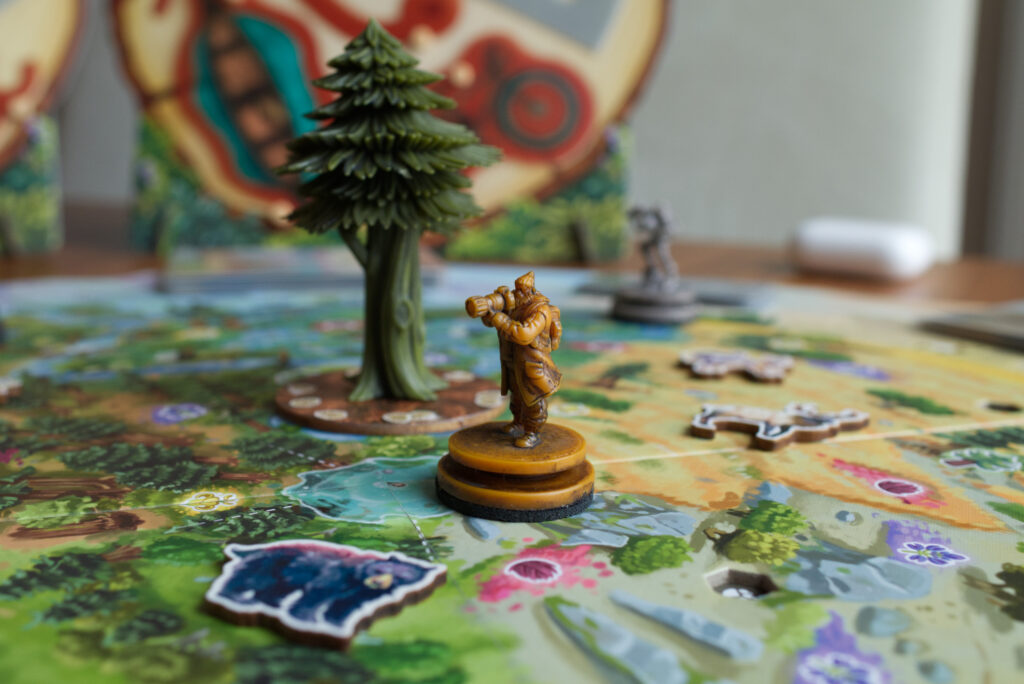
The most laborious part of setting up Redwood is to assemble the pattern holders and place all the patterns in there. The retail edition of Redwood comes without these stands which isn’t much of a loss in my opinion. In at least two places the holes for the pegs are too close together so it’s actually difficult to get the patterns in and out, and the angle of the stands is so steep that patterns constantly fall down during the attempt to pick them up or place them back on the boards. This could have been solved by designing them with a flatter angle, but that would have increased the table sprawl even more.
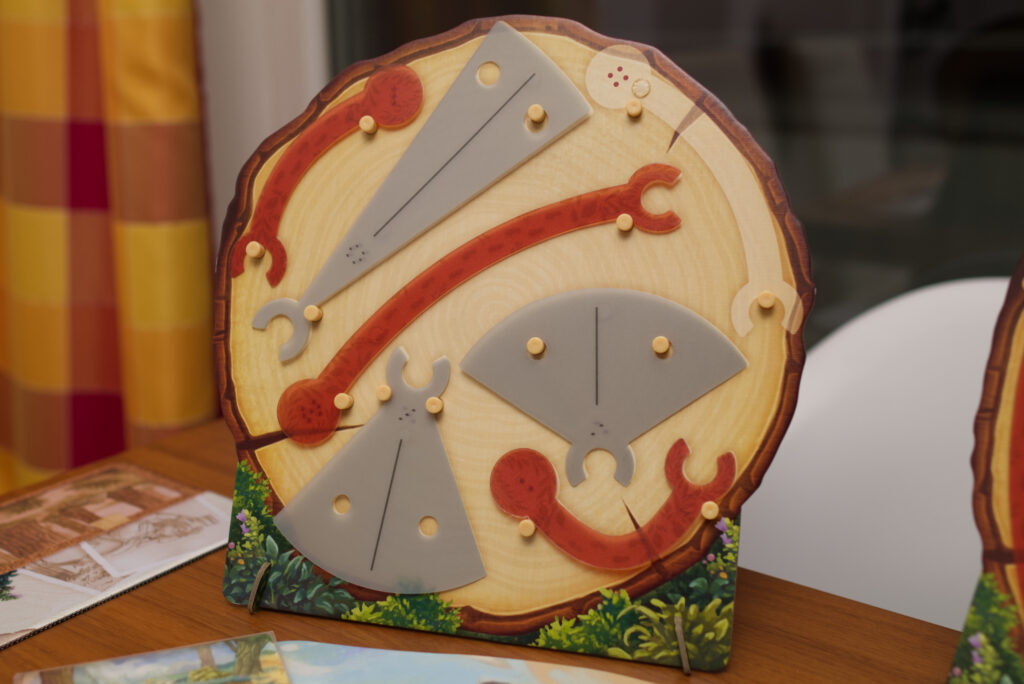
The Turn
The actual turn is quite simple: each round, the players one by one first perform a move and then take a picture. For that, they select both a movement pattern (red) and a lens (grey) from the ones that are available on the stands or those that are lying in front of other players boards from the previous round. If a player choses to do the latter, the player that previously had used the patterns gets a victory point in the form of a pinecone token. Players of course cannot try out movement patterns but have to assess the correct size and shape visually. If they have touched a pattern, that’s it, they have locked it in for that round.
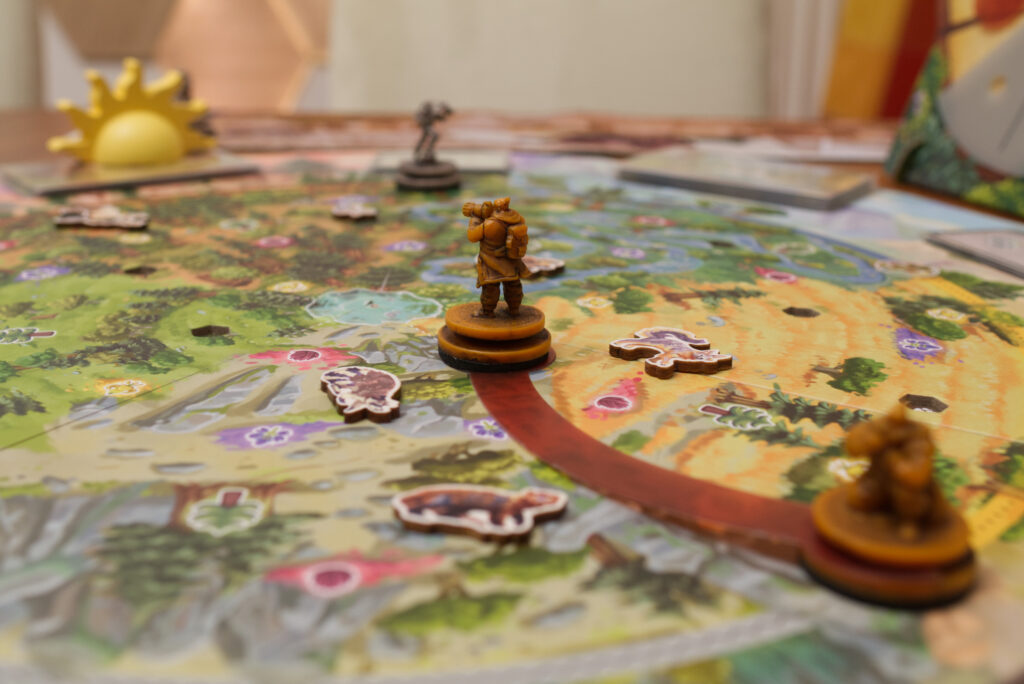
Once a player has selected both patterns, they first clip the red movement pattern onto their mini by lightly pressing on the head of the mini to make sure it doesn’t move. Then they clip the pattern on to the base of the mini and rotate it to choose their target position. Each movement pattern has a circle at its end that represents the end location of the movement. As long as the movement doesn’t end outside an outer circle drawn on the main board or goes over an animal or another player, it’s fine. They then use their second mini, position it on the end circle of the movement pattern and then pull the pattern away from under it. There, movement complete. The two minis have different poses, but that is purely cosmetic. In fact, even their orientation doesn’t matter.
In a similar fashion, the lens is also clipped on to the mini and can again be rotated. Everything that is fully covered by the lens pattern is considered photographed and the player takes a token corresponding to it, either the specific animal, flower or a tree. Even a little bit poking out disqualifies a subject from being photographed.

Each lens also has a centre line, the direction of which indicates which background is photographed. The player takes the top card of that sector’s panorama card stack and places it on their player board, either to the left or right of already existing cards. Each card shows 2 to 4 cross hairs which are basically slots to put photographed subjects on. So even if a player manages to fit multiple animals, flowers and a tree under their lens shape, they might only be able to place a few of those on the card.
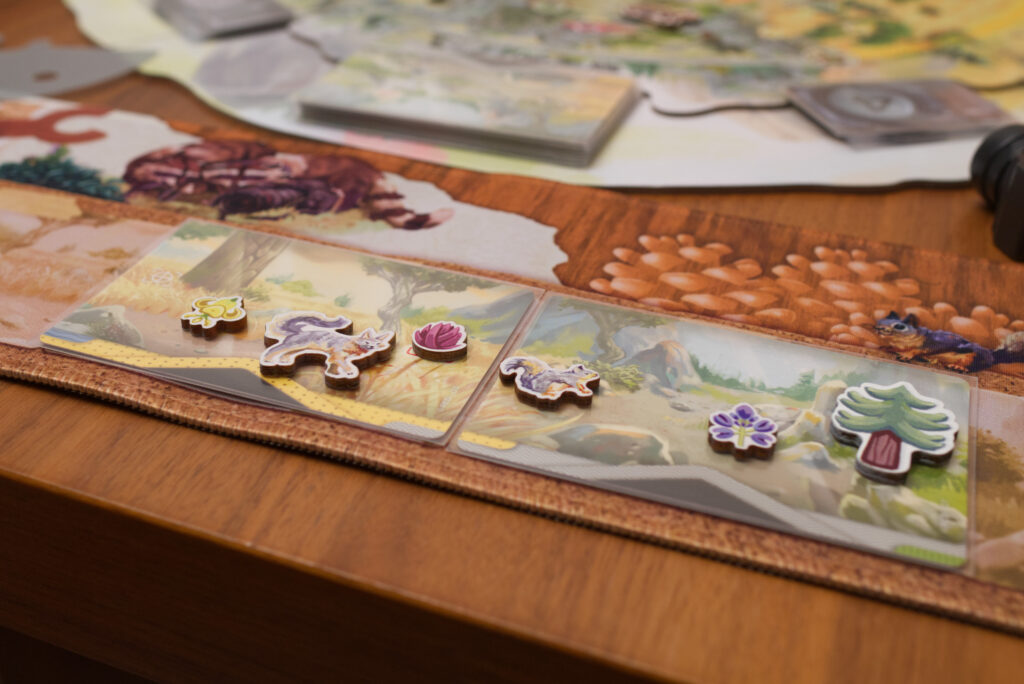
If the sector they have been photographing is the one containing the sun, they also place a sun token onto the panorama card. Finally, all photographed animals move and the active player has to place them into new locations. They then place the patterns they had used the previous round back on to the pattern stands and keep the ones from the current turn. Each player follows the same procedure and then the next round is started by advancing the sun to the next sector and revealing the next objective card.
Objective Cards and Card Constraints
So far, the game has a rather strong point-salad-whatever quality to it. Of course it is annoying when one has misjudged the length of a movement pattern or how much stuff can be fit in the area of a particular lens, but there is always another option available. The player can simply rotate the movement or lens and shoot something completely different than originally planned and still make some decent points.

The objective cards however act as incentive to plan shots more carefully. After each photo, the player checks all already revealed objective cards if their location and camera angle meets the conditions shown on them. For each that is met, 1 to 3 VP are awarded. These are things like having a subject poke out through one of the two holes in each lens, the photographer standing in a particular location when taking the shot, or only photographing specific things. The points gained this way can accumulate quickly with players easily getting a quarter of their total points from met objectives when done well.
The other mechanism to spice up the game are specific constraints printed on the backside of the panorama cards. That side is only used in the so called “advanced mode”, however I strongly recommend anyone reading this to immediately start with that mode. A constraint is a specially marked slot on the panorama card that can only hold a specific subject, e.g. a specific animal, a specific type of flower, etc. If a player can’t place that subject on there, the slot remains empty and counts as -3 VP at the end of the game which is quite painful. Overall, this forces players to consider more which background they photograph from where and when. Sometimes it’s better to wait for someone else to take that sector’s top card and hope for an easier constraint on the next revealed card.

Game End
At the end of the game, there is a whole set of possible sources of VP. Each animal is worth points, having a large number of different animals provides a healthy bonus, having photographed the sun only once provides positive points while having photographed it twice causes minus points, sets of flowers, photographing sectors in a consistent order, etc. However, any unfilled slot on a panorama card counts minus one VP, and the aforementioned constraint slots even minus 3 VP when left unfilled. The player with the most points wins.

Overall, a session of Redwood takes approx 45-60min, with repeat players taking longer than new ones as they try to optimise their images more. In the end, it’s just five rounds where every player just takes one picture.
Solo Mode
There is a dedicated solo mode in the game in the form of four scenarios that enforce certain constraints on the solo player. Overall, I lost interest in them quickly as the most interesting aspect of Redwood is missing: other player minis messing up one’s own plan. It’s equally fun and annoying when someone is simply standing in your way of taking that great picture and as a result you have to completely change your plan … after you have moved and selected your lens.
So I designed an alternate solo mode that has NPC minis running around on the board which at least for me produced a much more exciting experience that was also more true to how the multiplayer game feels. You can check it out here: Redwood Alternate Solo Mode: Crowded Park
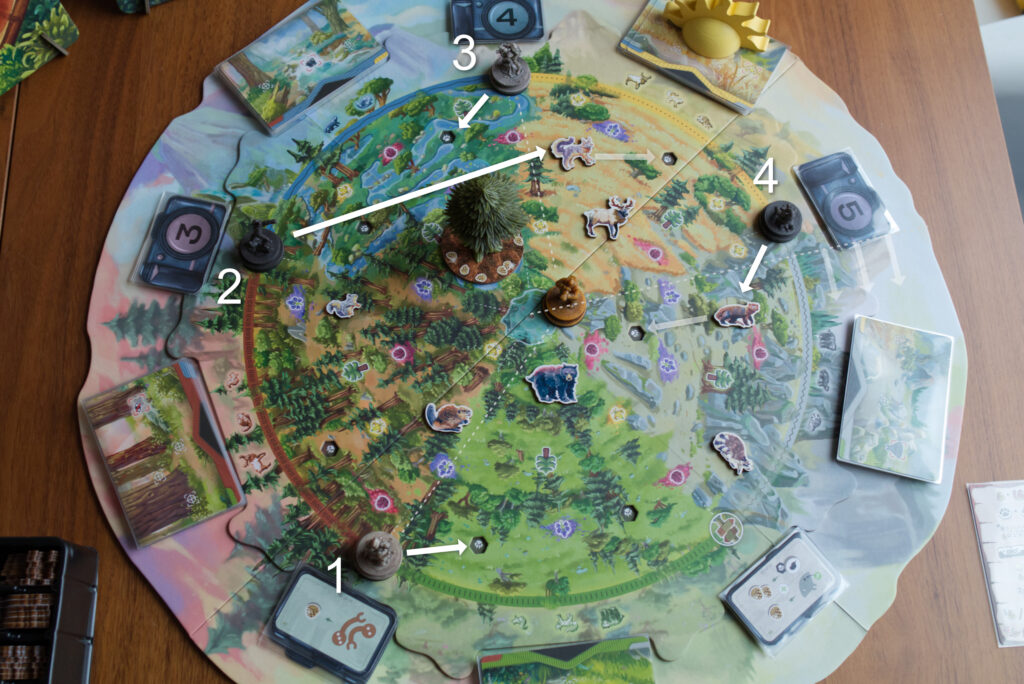
Expansion: Into the Wild
The expansion for Redwood introduces a number of modules that players can pick and choose from:
- Puma: adds certain panorama cards featuring a puma which can only be photographed if there is no other animal being photographed with it. Nice, but nothing to phone home about.
- Alternate animals: these replace the animals in the base game and come with an additional constraint on how to photograph them. Unfortunately, the shape of animals is quite similar to the ones in the base game, which is a missed opportunity (would have loved a long, thin snake or similarly odd shaped animals). As far as I can see, this could simply have been a deck of cards showing the constraint that were part of the base game. Their effect seemed to be less influential than the constraints introduced on the panorama cards in advanced mode
- One-time use effects: each player gets one at the start of the game and they feature effects such that you don’t have to move or can switch the lens after the fact. Okay, but didn’t change the general feel of the game.
- Modes of transport: this adds a bike, canoe and paraglider, which are basically just other forms of movement. I found them completely irrelevant and uninteresting.
- Camp: lets players reset their position a single time
- Scenic route: an alternate movement pattern that allows the player to pick up all flowers covered by the pattern as well.
- Zoom lens: for a long lens surprisingly wide, but has the disadvantage of a dead zone close to the photographer.
Unfortunately, none of them change the game in a significant way. The biggest effects of the expansion were when using the scenic route and zoom lens as replacement for some of the base patterns. However, this can mostly be simulated by simply removing one movement and one lens pattern at random at the start of the game.
There are also a few more objective cards (which is always welcome) and one more solo scenario.
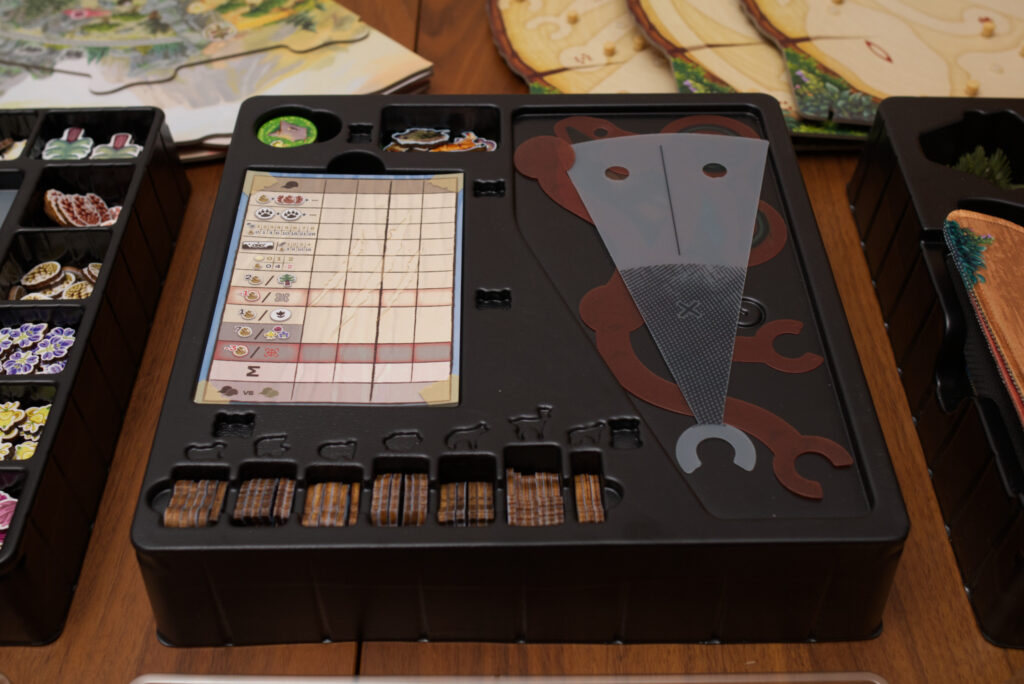
Expansion: KS Stretch Goals & The Majestic Bird of Prey
The KS stretch goals featured a number of new panorama cards with new types of constraints like the photographer having to stand on the lake in the centre of the board when taking the picture. I liked these quite a bit. There is also five more objective cards, which makes a big difference because there are so few objective cards in the base game to begin with.
I’m actually not quite sure if The Majestic Bird of Prey was part of the KS or an Essen promo or so. It consists of just two cardboard tokens showing a hawk in flight and sitting down. The hawk starts out next to the first objective card and if someone manages to achieve both conditions printed on the card, the hawk flies to them. If they do it again before another player managed to do so, it stays permanently with them and will score at the end of the game. I haven’t been able to try it but this one actually sounds quite fun.
Expansion: Big Box Exclusives
The big box comes with some extra gameplay content that is not otherwise available. Unfortunately, these are the two modules I found the most interesting from all the expansion content! One is a tree mini that is placed on the board during setup and simply is in the way. Especially when playing 2 or three players, it makes the board a little bit tighter and increases the chance that someone screws up a shot. I really like it and wished 2-3 of these (or smaller stones or something) would have been part of the base game.

The other module is a small deck of constraint cards. During setup, one is drawn and that defines a knock out criteria for everyone. For example, one requires players to have photographed at least 3 trees, otherwise they are automatically disqualified from final scoring. Some of them are rather easy (e.g. don’t photograph the same animal twice) but others are quite challenging. After the tree mini and having more panorama and objective cards, this is my favourite module to have.
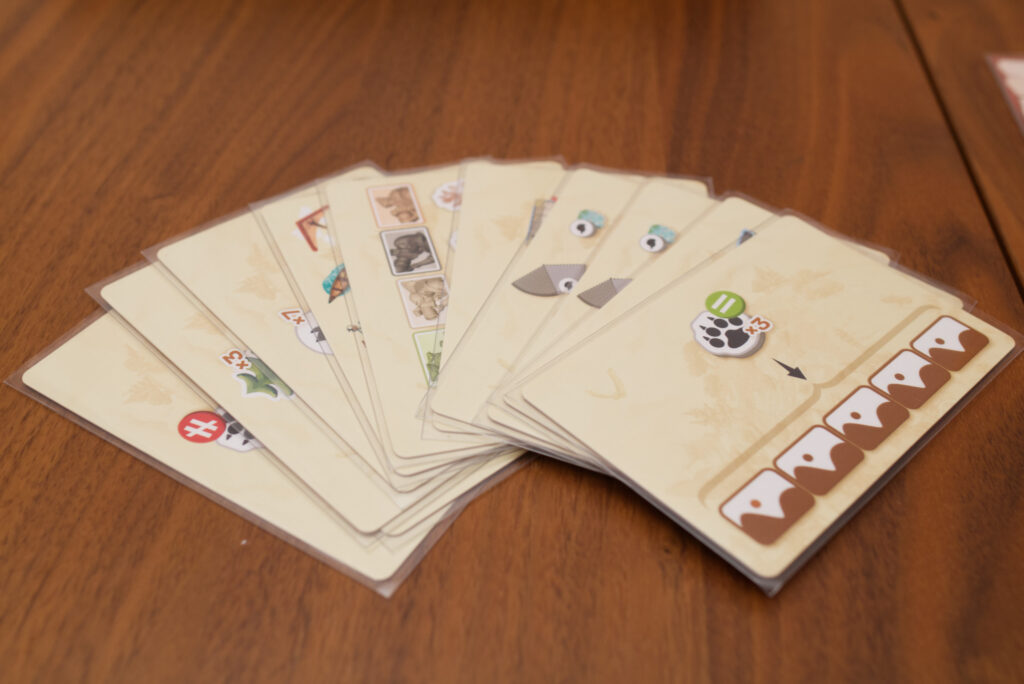
Optional Add-Ons and Choosing the Right Edition
As optional add-ons, backers could chose to get neoprene mats instead of the cardboard player boards and wooden animal tokens instead of the cardboard tokens that come in the box. I’m not a fan of neoprene in general and cardboard animals would have been just fine for me (especially since the ones placed on the board are wooden in all editions), so I see this as a completely optional thing. If you love that stuff, get it, otherwise save your money.
All of this raises the obvious question: which is the right edition / pledge to get? After trying pretty much all of the content, I would recommend going with the base KS pledge or the retail edition. I hardly ever use the Into the Wild content and it in my opinion doesn’t change the gaming experience in any meaningful enough way to justify the price or shelf space. Not having the big box extras would be sad, but the tree can somewhat be approximated by placing a player mini of a non-chosen colour on to the board as a blocker and the constraint cards you can simply read up in the rules. Not getting the big box has another benefit besides saving on money and space: you get the way nicer cover. The standard cover of Redwood is one of the most beautiful covers I have seen in a while, but for some reason, the publisher decided to not go with it on the big box. I’m quite sad I don’t have that lovely cover on my shelf …
The retail edition looks like a really good deal: it features the same minis (without wash) and plastic patterns without the strange pattern holders and the main board isn’t dual layer. There are no player boards, but that also isn’t dramatic. The thing I would miss the most would be the KS stretch goals because there are so few objective cards in the base game that they repeat quickly. So when it comes to choosing an edition, I would suggest: KS base pledge over retail over big box (and skip the neoprene and wooden tokens).
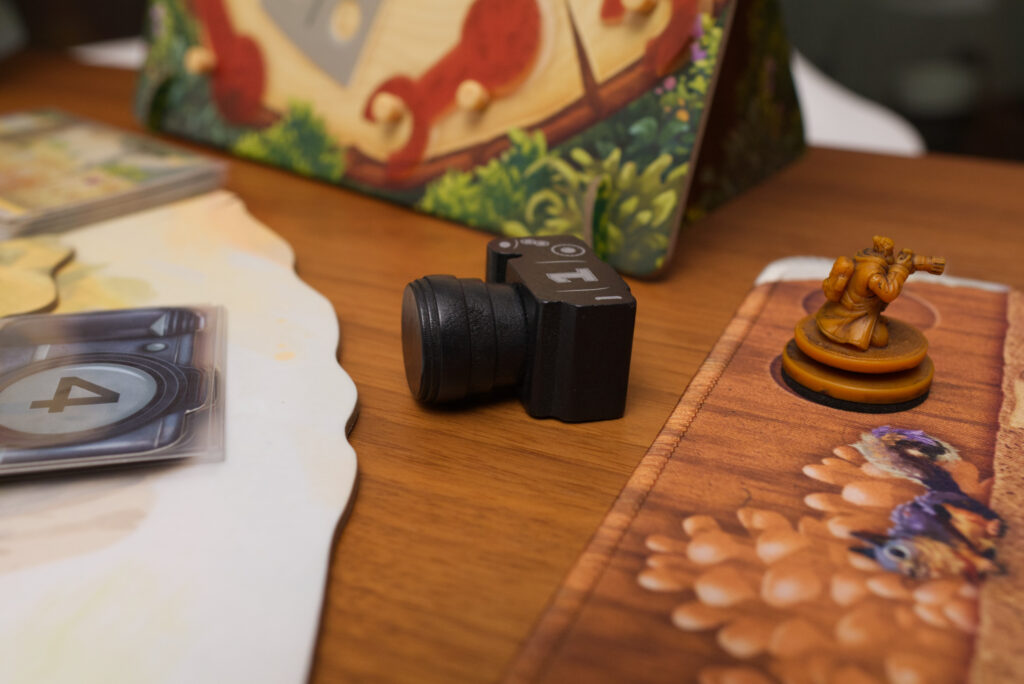
Production Oddities
Finally, I want to highlight some production oddities … I’m not quite sure if I would classify them as “issues”. The most dramatic is that the animals that are placed on the board (not the tokens placed on the photos) have a hex shaped piece glued to their underside so they can be slotted into matching hex-shaped holes on the board. Apparently, something happened during the manufacturing process of the board so that the holes shrunk by a tiny fraction which made them a very snug fit for the animals. Pulling the animals in and out of the holes repeatedly either ran the danger of damaging the board or in some cases caused the underside of the animals come loose. The publisher therefore kindly provided a new set of animal tokens (already were in ziplock bags underneath the box that I almost had missed and thrown away with the shipping package) where the hex shape is a tiny fraction smaller so they easily fit into the holes. I’m sure that was quite expansive for them, but totally worth it. For some reason though, the replacements were missing one of the animals. I hope that was just the case for me and not a wider problem.
Then there are the expansion objective cards … or rather they aren’t. For some reason, instead of the objective cards from Into the Wild, I had another copy of the objective cards of the KS stretch goals. I’m quite sad about that one as more variety in the objective cards would definitely have helped. I contacted the publisher but haven’t heard back from them which is also a little bit worrying.
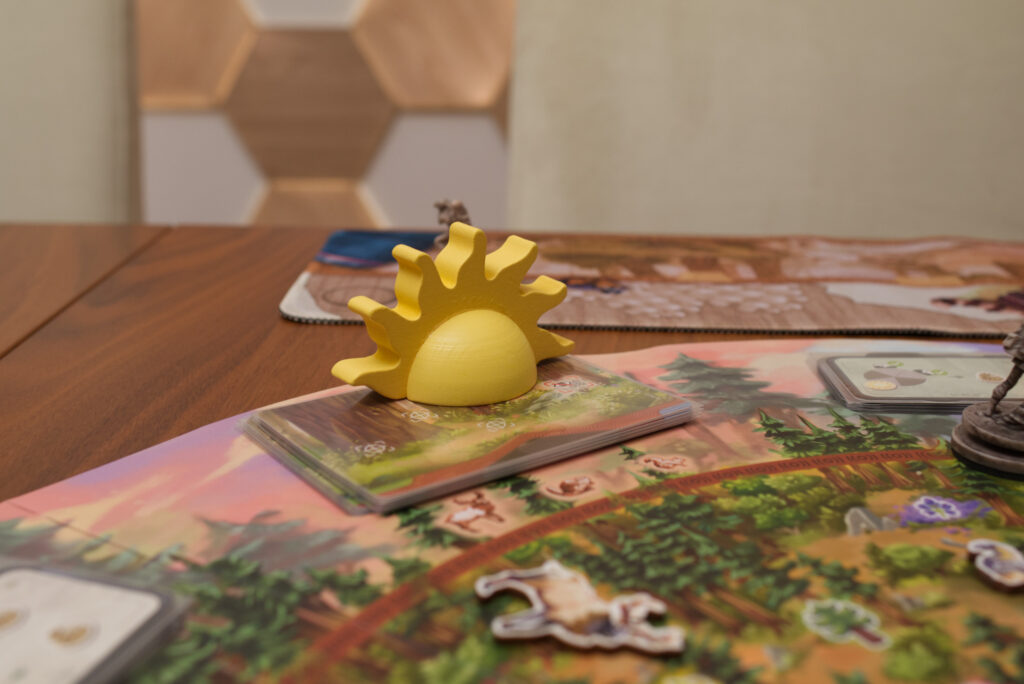
The rest is minor stuff but still a bit concerning considering the price of the product: some of the corners of the main board already curl up as if they started to delaminate. It’s not much, but a bit of an issue for the corners at the centre of the board when players rotate movement patterns into them. The lens patterns are so opaque that one cannot really see the flowers one might have covered with them, the sun looks oddly un-detailed compared to the minis and way too big, the lids of the plastic trays don’t properly stay shut, and the separators to store the pattern stands assembled with their pegs are simply pieces of cheap brown cardboard. The KS page had mentioned some foam stand-ins, but I assume that would have completely messed up the budget. Overall it felt to me like the big box hadn’t quite gone as planned, with the size so much bigger as shown in the renders and everything, and I wouldn’t be surprised to learn that the publisher produced them at a loss. Finally, the plastic patterns are kind of worrying. So far, they held up well, but everyone I played with was concerned of breaking something … or at least wondering how long they might last.
Overall, there are indeed a number of odd decisions in this production, but also a lot of things that are simply glorious: the washed minis (and having two different ones per player, one standing, one in shooting pose), the cute first player marker, the illustrations on the board and box, … one of my favourite details are the black neoprene pads that get stickered under the minis to prevent them from moving around accidentally. This is such a small but important touch, it immediately makes the game feel more high-quality. In some sense, the big box especially feels less like a game and more like a piece of art.
Conclusion
Same as with publisher Sit Down!’s previous game Tiwanaku, I was surprised to discover how much I liked Redwood. Of course, the theme and artwork are glorious. But the actual game play is nice as well … as long as one uses the advanced mode and has three or more players involved (or NPCs using my solo mode). Playing Redwood two player with the normal mode was so point-salad-whatever feeling that it gave little incentive to play again. I personally would only consider playing this mode in a family setting with small children. Using the advanced mode already helped a lot, but as soon as more players, the tree, and/or NPCs were added, the chances of messing up a shot increased a lot and that made the game way more exciting. At its high points, Redwood feels like playing Billiard as a novice: in theory it seemed all very simple and straight forward, but then you execute and start cursing yourself as things start to come apart.
There are a number of things in Redwood that left me puzzled: why for example use pinecones as VP for wildlife photographers? Why add boards / neoprene mats for the animal and resource tokens if the game comes with trays that neatly sort them? Why no board adjustments for smaller player counts? Why all this expansion content and then it has so little impact on the base game formula? In some sense, it feels like decisions were made to cater towards what looks good during crowd funding rather than double down on the interesting bits of the base game.
The main issue I found with Redwood is that it walks on a thin line between arbitrariness and disaster. In most pattern-move games I’ve played, the game has multiple rounds and so skill can prevail over the occasional disaster. Take for example the aforementioned Techno Witches: it’s a race and if you pick the wrong pattern, you fall behind but can still catch up as others will make mistakes too. There is also at all times a clear sense of whether or not your are doing well. This is not so here.

In Redwood, doing a “prefect” shot where nothing stays empty on the panorama card still doesn’t feel like an achievement to celebrate, more like something to nod off and plan the next move. It becomes difficult to get emotionally invested or excited about a game when you neither really care about your own move nor that of others. The difference between a good shot and a bad shot might just end up being 2-3 VP. Sure, there were situations where people came in my way or took the panorama card I wanted, but it was rarely intentionally and there was no real sense of who’s winning during the game. In that sense, Redwood felt a little too multiplayer-solitaire for my taste.
Overall, my experience with Redwood can best be summed up by a statement and an observation. The former is from a friend who asked me “but how often will you actually get such a light family-style game to the table?”, which is a very valid question, considering the sizeable amount of shelf space I will need to clear to store this game and the equally large amount of money that I have invested in that box. I might end up selling the all-in box and getting a retail copy instead. But then it loses a bit of its specialness and I would likely get it to the table even less.
The observation I mentioned is that with my group of players – most being firmly in the mid-heavy sector of the hobby – I only found a single person who was interested in trying Redwood maybe one more time. It’s not surprising because despite all that extra content, there is little to truly mix up the formula or provide a serious challenge. The constraint cards have the best chance to do that, but they come only in the big box. I’d have loved to see 2-3 blocker minis (or cardboard tokens) and a way larger variety of objective cards in the base game. Or the expansion to add completely different animal shapes or other new challenges. The zoom lens and scenic route were a step in the right direction but can too easily be ignored even when they are added, they are so non-essential. So I find myself mostly playing Redwood solo with my own solo mode, trying to squeeze in good shots when all those NPC’s keep ruining my plans.
I still haven’t completely made up my mind when it comes to Redwood, which is unusual for me. After the amount of plays I had, I usually know exactly what in can get out of a game. In this case however, I can still see myself equally keeping the big box, downgrading to a retail edition, or selling the game completely. I’ve definitely grown fond of this game. In a sense, I even adore it a little bit, but that is mostly due to its theme and presentation. If I had casual / non-gamers in my life, Redwood might be a game to get them interested in playing with me. But I feel it would yet again be an “oh, that’s nice” but no “let’s play that again”.
My recommendation so far – if you’re interested in Redwood – would be: a) go with the KS base pledge or retail and b) make sure you have players that are up for repeated plays of a light game with a lovely theme. I’m definitely enjoying this game but in the end, it still remains a “choose your pattern and move” game with just five short rounds, despite the extravagant presentation.
